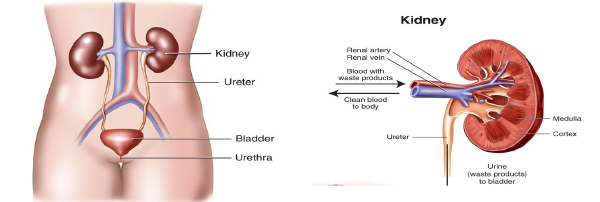Statistics indicate that 1 in 10 persons in the general population are estimated to have some form of chronic kidney disorder (CKD)1.By 2030, India is expected to have the world’s largest population of patients with diabetes.1.3 billion people are served by 1850 nephrologists who are unequally distributed. Even today, over 90% of patients requiring Renal Replacement Therapy in India die because of inability to afford care, and even in those who do start Renal Replacement Therapy, 60% stop for financial reasons.There are over 130,000 patients receiving dialysis, and the number is increasing by about 232 per million population, a reflection of increasing longevity in general2. It has also been estimated that about 60% to 70% of CKD cases are offshoots of diabetes and hypertension1
Kidneys
The main job of kidneys is to regulate the amount of water in the body and balance the concentration of mineral ions in the blood. They also get rid of waste products, especially a nitrogen-containing compound called urea. At the same time they hold on to useful substances such as glucose and protein so none is lost from the body.
Understand your disease
Chronic kidney disease occurs when one suffers from gradual and usually permanent loss of kidney function over time. This happens gradually, usually over months to years. it includes conditions that damage kidneys and decrease their ability to keep doing the Functions.
“CKD is defined as kidney damage or glomerular filtration rate (GFR) <60 mL/min/1.73 m2 for 3 months or more, irrespective of cause”.
Functions of Kidney:
Filtration
cells and large proteins are retained while materials of smaller molecular weights are filtered from the blood to make an ultrafiltrate that eventually becomes urine.
Reabsorption
Water, Glucose , Amino acids are completely reabsorbed in the proximal tubule to avoid loss of these in Urine.
Homeostasis
Your body is made up of millions of cells. For them to work properly, the conditions inside your body need to be as constant as possible. However everything you do tends to change your internal conditions; Homeostasis describes the functions of your body which work to keep your internal environment constant within a very narrow range. One of your most important organs of homeostasis is the kidne
The kidneys also produce certain hormones that have important functions in the body, including the following:
- Active form of vitamin D (calcitriol or 1,25 dihydroxy-vitamin D), which regulates absorption of calcium and phosphorus from foods, promoting formation of strong bone.
- Erythropoietin (EPO), which stimulates the bone marrow to produce red blood cells.
- Renin, which regulates blood volume and blood pressure in association with aldosterone manufactred in the adrenal glands, located just above the kidneys.

Stages of CKD:
Stage 1
Slightly diminished function; kidney damage with normal or relatively high GFR (≥90 ml/min/1.73 m2) and persistent albuminuria. Kidney damage is defined as pathological abnormalities or markers of damage, including abnormalities in blood or urine tests or imaging studies. Below points are to be taken care of:
- Control blood sugar if you have diabetes.
- Keep a healthy blood pressure.
- Eat a healthy diet.
- Do not smoke or use tobacco.
- Exercise 30 minutes a day, 5 days a week.
- Keep a healthy weight.
- Ask a doctor if there are medicines you can take to protect your kidneys.
- Make an appointment to see a nephrologist, even if you already have a general doctor.
Stage 2
Mild reduction in GFR (60–89 ml/min/1.73 m2) with kidney damage. Kidney damage is defined as pathological abnormalities or markers of damage, including abnormalities in blood or urine tests or imaging studies.
Below are ways to slow kidney damage in Stage 2 kidney disease:
- Control blood sugar in case of diabetes.
- Keep a healthy blood pressure.
- Eat a healthy diet.
- Do not smoke or use tobacco.
- Exercise 30 minutes a day, 5 days a week.
- Keep a healthy weight.
Stage 3
Moderate reduction in GFR (30–59 ml/min/1.73 m2): British guidelines distinguish between stage 3A (GFR 45–59) and stage 3B (GFR 30–44) for purposes of screening and referral.
- Swelling in the hands and feet.
- Back pain.
- Urinating more or less than normal.
By Stage 3 kidney disease, there are more likely to have health complications as a result of waste building up in body. Common complications from kidney disease are high blood pressure, anemia, and bone disease.
Stage 4
Severe reduction in GFR (15–29 ml/min/1.73 m2).Preparation for renal replacement therapy.
- Swelling in the hands and feet
- Back pain.
- Urinating more or less than normal.
By Stage 4 kidney disease, there are other health complications as a result of waste building up in body. Common complications from kidney disease are high blood pressure, anemia, and bone disease.
Stage 5
Established kidney failure (GFR <15 ml/min/1.73 m2), permanent renal replacement therapy, or end-stage kidney disease.
- Itching
- Muscle cramps
- Nausea and vomiting
- Not feeling hungry
- Swelling in the hands and feet
- Back pain
- Urinating more or less than normal
- Trouble breathing
- Trouble sleeping
Once kidneys have failed, there is need to start dialysis or have a kidney transplant to live

- GFR level (mL/min/1.73 m2)
- ≥ 90
- 60 – 89
- 30 – 59
- 15 – 29
- < 15